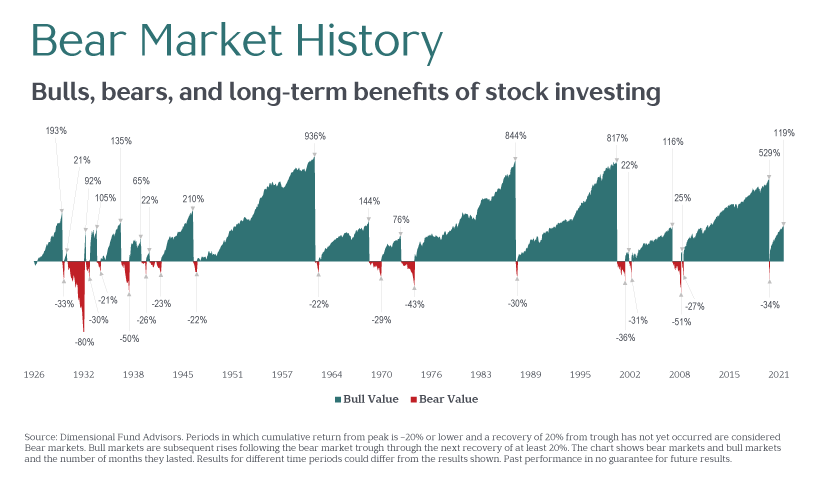Disappointing performance over the past few weeks has pushed U.S. stocks to new lows for the year and back into “bear market” territory. A bear market is typically defined as a drop of 20% or more from a recent high.
Investors may naturally wonder if more market pain is yet to come and, if so, should they be doing something different? While we’re not prone to offering forecasts, we believe the “bear necessities” of successful investing are no different today than they’ve ever been.
Looking Up While We’re Feeling Down
Despite the very real, and long list of, concerns we’re facing around the world, the simple truth is market downturns happen. That’s to be expected.
Sure, investors can point to what makes today’s environment different from the past and allow that uncertainty to erode the confidence they have in their current plans and portfolios, but investing is always uncertain. It is precisely the nature of risk that provides compensation to those willing to bear it. When risk shows up, we should embrace it for what it is—an expected part of the plan.
And, if we temper our emotions and take a step back, we see that bear markets—like the one we find ourselves in today—have historically been far fewer and much less intense than the bull markets that have preceded and followed them.
The graphic below shows stock market returns, divided into bull and bear markets, since 1926. Bull markets are shown in green and bear markets in red. The percentage return labels associated with each period indicate the cumulative gain or loss for each bull and bear market, respectively.

The keen observer will notice there are 35 periods on this chart, with just one more bull than bear market. Despite an almost equal split between good and bad periods, the magnitude of bull markets is hard to miss.
Underlying the graphic above are a few powerful statistics:
- The average length of a bear market has been 10 months, while the typical bull market has lasted 55 months.
- The worst bear market saw stocks fall a stunning 80%; the strongest bull market saw stocks surge more than 900%.
- The average drop for stocks during a bear market has been 35%, while the average gain during a bull market has been 250%.
The takeaway? Despite many setbacks, stocks have delivered handsome rewards to disciplined investors.
Why Not Escape the Worst?
You wouldn’t be human if a part of you didn’t look at the graphic above and wonder how you could avoid the “red” and get back in time for the “green.” You can thank the hardwiring in your brain for that.
The problem is, while it’s easy to see the turning points from bear to bull in hindsight, it is nearly impossible to spot them in real time. Plus, some of the market’s best returns have often arrived while employment, geopolitical, and other news is still bad. By the time the economic news turns positive, prices have moved higher. You don’t get good news and low prices.
Missing just a few good days, too, can take a real dent out of the mountains of green. Consider that the annualized compound return of the S&P 500 Index was 10.7% from 1990 through 2021. But, if you’d missed the best 25 days—fewer than one day per year, on average—returns were nearly cut in half, to just 5.6%.
Enduring Wisdom
Investing isn’t about trying to beat the market by guessing whether it’s about to flash red or green. It’s about temperament, prudence, and favoring what’s probable over what’s possible.
Successful long-term investing is about adhering to time-tested principles such as asset allocation and diversification, disciplined rebalancing, and working to drive down costs and taxes. It’s about controlling what we can control and not worrying about the myriad factors we can’t.
This approach may not sound so flashy. But history is strongly on the side of investors who accept occasional downturns—like the bear market we’re all in together—as the cost of long-term investment success.
